This post may contain affiliate links. Please read our disclosure policy.
Super soft and rich Indonesian prune roll cake or known as bolu gulung prunes is a must to try. The recipe is economical without using lots of eggs like the traditional recipe, but our family truly enjoys this recipe.

What is bolu gulung prunes?
Bolu is a general term for cake and gulung means to roll in Indonesian language. So it’s literally translated to roll cake. If you are familiar with Swiss roll cake, this is basically what it is. The cake is studded with dried prune pieces that have been flattened.
Bolu gulung prunes vs lapis legit roll
The two almost bear resemblances. However, bolu gulung prunes are not as rich compared to lapis legit roll. Lapis legit roll is a modern twist on the traditional lapis legit (Indonesian thousand layer butter cake). Lapis legit roll is fast to make because the cake sheet is rolled up like a Swiss roll cake, creating that “faux” thousand layer effects. Lapis legit has more of the swirl pattern . Bolu gulung prunes doesn’t. At least that’s my own observation.

Why you’ll love this recipe
1. Amazing texture and taste
Despite only using 6 eggs, this bolu gulung prunes has an amazing soft, moist, but not dense texture. It gives you that rich taste or what we call “legit” in Indonesian without the massive amount of calories like lapis legit roll would.
2. No Emulsifier is used
Most Indonesian cake recipes uses emulsifier or what usually known as SP or TBM. These are not commonly used in this part of the world. The emulsifier helps to ensure that the cakes will rise well and fluffy. I can ensure you even without the addition of the emulsifier, this cake rises well and the texture is so soft and fluffy
How to make really good bolu gulung prunes
1. Flatten the prunes gently between two fingers. Taking care not to break it into pieces. We want them in whole thin pieces. You can also do this in between two cling wrap
2. Preheat oven to 375 F (190 C) for conventional oven, 350 F (180 C) for convection oven. I use a 14.5 x 10 x 1 inch (37 x 25 x 2.5 cm) baking pan. Line only the bottom of the pan with parchment paper for easier removal later. DO NOT line or grease the side of the pan
3. Melt the butter and let it cool down. Please make sure the whole eggs and egg yolks are at room temperature. Put eggs, sugar, and vanilla extract in a mixing bowl. 
4. Beat on medium speed (speed 4 on KA) for 1 minute using a whisk attachment and then increase to high speed (speed 8). Beat until the mixture is thick, creamy, and pale. When you lift the batter with the whisk, the batter that drops down will leave a trail that remains visible for about a minute before slowly disappearing. You have to beat it to this ribbon stage or the cake will not turn out right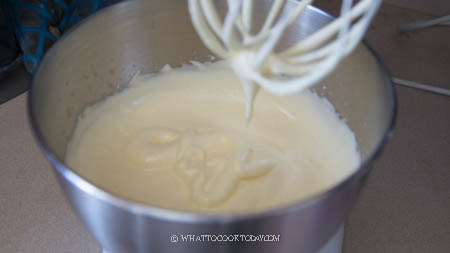
5. Once it has reached the ribbon stage, turn off the mixer. Add 1/3 of the flour mixture and very gently but work efficiently, fold the flour mixture into the batter using a rubber spatula using a swipe down and fold over method. Then add the next batch of flour and continue to fold.
6. Once you no longer see any loose flour in the batter, scoop out about 1/3 cup of the batter into a different bowl. Add melted butter and stir to combine thoroughly using a whisk. 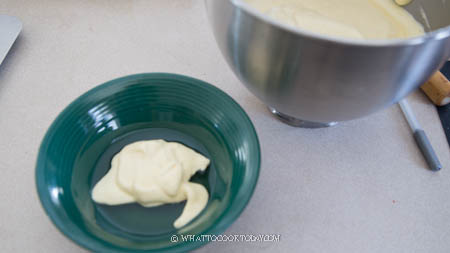
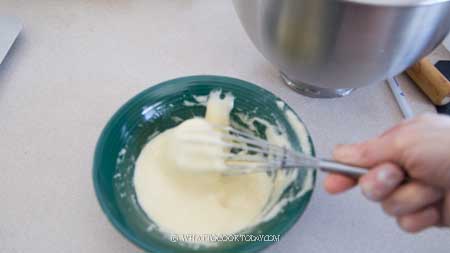
7. Pour this mixture gently over the batter and use a spatula to fold again until combined. Make sure they are thoroughly combined into the batter or your cake will have separate layers later
8. Pour the well-combined batter into the prepared pan. Bang the pan on the counter 2-3 times to pop any large air bubbles. Place the pan on the middle rack and bake for 10 minutes or until the surface of the cake has formed a crust.
9. Remove the pan from the oven and quickly arrange the flattened prune pieces on the half-baked cake batter
10. Put the baking pan back into the oven and bake for another 8 minutes or until the top is dry to the touch and no longer sticky and bounces back when you gently press on it. It is important not to overbake the cake but you also want to make sure the surface is dry enough, otherwise, the “skin” will peel off when you roll the cake
11. Immediately when the cake is out of the oven, use an offset spatula to loosen the four edges of the cake.
12. Put a large piece of parchment paper on top. 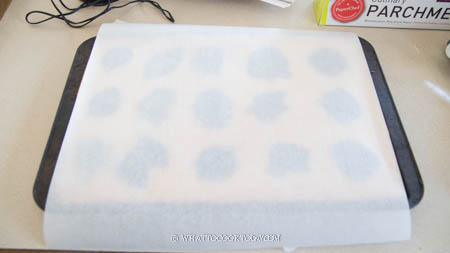
13. Flip over to the other side and peel off the parchment paper. The cake should be soft. If there is a crust on the edge, trim those off so you won’t have a problem rolling the cake
14. Spread some condensed milk on the entire surface of the cake. This acts as a “glue”. You can also apply a jam of your choice instead of condensed milk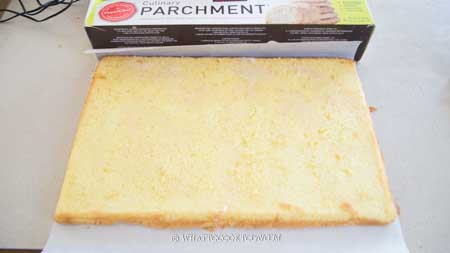
15. Place a heavy object on the opposite site of the cake so that the opposite end of the cake won’t move as you roll the cake up. Very gently lift the parchment paper on the side near you and fold the cake over and continue to roll with the help of the parchment paper and roll as tightly as you can until you reach the other side
16. Tuck the top of the parchment paper under the cake using a bench scraper while pulling the parchment paper underneath to tighten the roll
17. Gently unroll the parchment paper. The cake should stay rolled up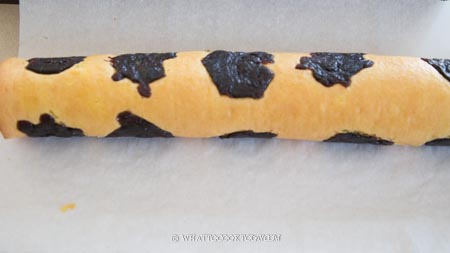
Age it for 24 hours before serving
The cake tastes really good the next day as the flavor has developed. The texture is really soft, and moist but not dense. If you can’t wait that long, you can serve it on the same day after it has cooled down completely, but you may find that the cake feels a bit drier in texture. So I highly recommend that you wait! Your patience will pay off!

How to store
Let the cake cool down completely at room temperature. The cake can be kept in an air-tight container for 3-4 days. They stay really moist and soft
Did you make this recipe?
I love it when you guys snap a photo and tag it to show me what you’ve made. Simply tag me @WhatToCookToday #WhatToCookToday on Instagram and I’ll be sure to stop by and take a peek for real!

Bolu Gulung Prunes /Prune Roll Cake
Ingredients
- 165 g eggs from 3 large eggs
- 54 g egg yolks 3 large egg yolks
- 60 g cake flour
- 80 g sugar
- 5 g milk powder
- ¼ tsp salt
- ½ tsp baking powder
- ½ tsp vanilla extract
- 80 g unsalted butter melted
- 15 pieces prunes
- Condensed milk as needed
Instructions
Things to prepare before you prepare the batter:
- Flatten the prunes gently between two fingers. Taking care not to break it into pieces. We want them in whole thin pieces. You can also do this in between two cling wrap
- Preheat oven to 375 F (190 C) for conventional oven, 350 F (180 C) for convection oven.
- I use a 14.5 x 10 x 1 inch (37 x 25 x 2.5 cm) baking pan. Line only the bottom of the pan with parchment paper for easier removal later. DO NOT line or grease the side of the pan
- Melt the butter and let it cool down. Please make sure the whole eggs and egg yolks are at room temperature
Prepare the batter:
- Put eggs, sugar, and vanilla extract in a mixing bowl. Beat on medium speed (speed 4 on KA) for 1 minute using a whisk attachment and then increase to high speed (speed 8). Beat until the mixture is thick, creamy, and pale. When you lift the batter with the whisk, the batter that drops down will leave a trail that remains visible for about a minute before slowly disappearing. You have to beat it to this ribbon stage or the cake will not turn out right
- Once it has reached the ribbon stage, turn off the mixer. Add 1/3 of the flour mixture and very gently but work efficiently, fold the flour mixture into the batter using a rubber spatula using a swipe down and fold over method. Then add the next batch of flour and continue to fold.
- Once you no longer see any loose flour in the batter, scoop out about 1/3 cup of the batter into a different bowl. Add melted butter and stir to combine thoroughly using a whisk. Pour this mixture gently over the batter and use a spatula to fold again until combined. Make sure they are thoroughly combined into the batter or your cake will have separate layers later
Baking:
- Pour the well-combined batter into the prepared pan. Bang the pan on the counter 2-3 times to pop any large air bubbles. Place the pan on the middle rack and bake for 10 minutes or until the surface of the cake has formed a crust. Remove the pan from the oven and quickly arrange the flattened prune pieces on the half-baked cake batter
- Put the baking pan back into the oven and bake for another 8 minutes or until the top is dry to the touch and no longer sticky and bounce back when you gently press on it.
- It is important not to overbake the cake but you also want to make sure the surface is dry enough, otherwise, the "skin" will peel off when you roll the cake
Roll the cake:
- Immediately when the cake is out of the oven, use an offset spatula to loosen the four edges of the cake. Put a large piece of parchment paper on top. Flip over to the other side and peel off the parchment paper. The cake should be soft. If there is a crust on the edge, trim those off so you won't have a problem rolling the cake
- Spread some condensed milk on the entire surface of the cake. This acts as a "glue". You can also apply a jam of your choice instead of condensed milk
- Place a heavy object on the opposite site of you so that the opposite end of the cake won't move as you roll the cake up
- Very gently lift the parchment paper on the side near you and fold the cake over and continue to roll with the help of the parchment paper and roll as tightly as you can until you reach the other side
- Tuck the top of the parchment paper under the cake using a bench scraper while pulling the parchment paper underneath to tighten the roll
- Gently unroll the parchment paper. The cake should stay rolled up
Serve the cake the next day if possible:
- The cake tastes really good the next day as the flavor has developed. The texture is really soft, and moist but not dense
How to store:
- The cake can be kept in an air-tight container for 3-4 days. They stay really moist and soft


